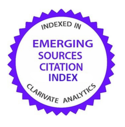Mortalidad de futbolistas de élite en España y Portugal
DOI:
https://doi.org/10.26360/2020_6Palabras clave:
futbolistas de élite, medidas de mortalidad, Portugal, EspañaResumen
Los beneficios para la salud derivados del ejercicio regular están científicamente probados. Sin embargo, cuando se trata de deportistas profesionales, cuya actividad física es muy intensa, los beneficios ya no son una evidencia clara. El objetivo de este trabajo es investigar si los deportistas de élite viven más tiempo que la población general. Se recogieron datos sobre la fecha de nacimiento y muerte (en su caso) de los jugadores portugueses y españoles que representaron su selección, así como otras variables de interés. Cada grupo de jugadores se compara con la población general del país respectivo, utilizando los datos disponibles en la Human Mortality Database y cuatro enfoques diferentes. Al final, también se compara la mortalidad de futbolistas portugueses y españoles.
Descargas
Citas
Abel, E. L., and Kruger, M.L. (2005). Longevity of major league baseball players. Research in Sports Medicine, 13(1), 1–5.
Andersen, P. K. (2013). Decomposition of number of life years lost according to causes of death. Statistics in Medicine, 32, 5278–285.
Antero-Jacquemin, J., Pohar-Perme, M., Rey, G., Toussaint, J.F., and Latouche, A. (2018). The heart of the matter: years-saved from cardiovascular and cancer deaths in an elite athlete cohort with over a century of follow-up, European Journal of Epidemiology, 33 (6), 531–43.
Baron, S.L., Hein, M. J., Lehman, E., and Gersic, C.M. (2012). Body mass index, playing position, race, and the cardiovascular mortality of retired professional football players. The American Journal of Cardiology, 109, 889–96.
Beaglehole, R., and Stewart, A. (1983). The longevity of international rugby players. The New Zealand Medical Journal, 96, 513–15.
Belli, S. and Vanacore, N. (2005). Proportionate mortality of Italian soccer players: is amyotrophic lateral sclerosis an occupational disease?, European Journal of Epidemiology, 20, 237–42.
Breslow, N. E., and Day, N. E. (1987), “Rates and Rate Standardization”, in Statistical Methods in Cancer Research: Volume II—The Design and Analysis of Cohort Studies. International Agency for Research on Cancer, Lyon: Oxford University press, 48–82.
Cox, D. R. (1972). Regression models and life-tables. Journal of the Royal Statistical Society, Series B (Methodological), Vol. 34, No. 2, 187-220.
Ederer, F., Axtell, L. M., and Cutler S. J. (1961). The relative survival rate: a statistical methodology. National Cancer Institute. Monograph, 6, 101–21.
Ederer, F., and Heise, H (1959). – The effect of eliminating deaths from cancer on general population survival rates, Methodological Note 11, End Results Evaluation Section. National Cancer Institute.
Gajewski, A. K., and Poznańska, A. (2008). Mortality of top athletes, actors and clergy in Poland: 1924–2000 follow-up study of the long term effect of physical activity. European Journal of Epidemiology, 23 (5), 335–40.
Hakulinen, T. (1982). Cancer survival corrected for heterogeneity in patient withdrawal. Biometrics, 38, 933–42.
Hurley, B. and Reuter, I. (2011). Aging, Physical Activity, and Disease Prevention. Journal of Aging Research, 2011, 1–2.
IFOA (2011). Core Reading: Subject CT5. The Actuarial Education Company. Institute and Faculty of Actuaries.
Kalist, D. E., and Peng, Y. (2007). Does education matter? Major league baseball players and longevity. Death Studies, 31(7), 653–70.
Keiding, N. (1987). The method of expected number of deaths,1786-1886-1986. International Statistical Review, 55(1), 1–20.
Klugman, S. A., Panjer, H. H., and Willmot, G. E. (2008), Loss Models: from data to decisions, 3rd ed., Hoboken NJ., John Wiley & Sons.
Knez, W. L., Coombes, J. S., and Jenkins, D. G. (2006). Ultra-endurance exercise and oxidative damage: implications for cardiovascular health. Sports Medicine, 36, 429–41.
Koning, R., Matheson, V., Nathan, A., and Pantano, J. (2014). The long-term game: an analysis of the life expectancy of national football league players. International Journal of Financial Studies, 2 (1), 168–178.
La Gerche A., Boyle, A., Wilson, A. M., and Prior, D. L. (2004). No evidence of sustained myocardial injury following an Ironman distance triathlon. International Journal of Sports Medicine, 25 (1), 45–9.
La Gerche, A., Burns, A. T., Mooney, D. J., Inder, W. J., Taylor, A. J., Bogaert, J., MacIsaac, A. I., Heidbüchel, H., and Prior DL (2012). Exercise-induced right ventricular dysfunction and structural remodelling in endurance athletes. European Heart Journal, 33, 8 (April), 998–1006.
Laslett, L., Eisenbud, E., and Lind, R. (1996). Evidence of myocardial injury during prolonged strenuous exercise. The American Journal of Cardiology, 78, 488–90.
Lee, I. M., and Paffenbarger, R. S. (2000). Associations of light, moderate, and vigorous intensity physical activity with longevity: The Harvard Alumni Health Study. American Journal of Epidemiology, 151, 3, 293–99.
Lee, I. M., Shiroma, E. J., Lobelo, F., Puska P., Blair, S. N., and Katzmarzyk, P. T. (2012). Effect of physical inactivity on major non-communicable diseases worldwide: an analysis of burden of disease and life expectancy. The Lancet, 380(9838) 219-229.
Lehman, E. J., Hein, M. J., Baron, S. L., and Gersic, C.M. (2012). Neuro-degenerative causes of death among retired national football league players. Neurology, 79, 1970–974.
Liddell, F. D. K. (1984). Simple exact analysis of the standardised mortality ratio. Journal of Epidemiology and Community Health, 38, 85–88.
Lin, Y., Gajewski, A. and Poznańska, A. (2016). Examining mortality risk and rate of ageing among Polish Olympic athletes: a survival follow-up from 1924 to 2012. British Medical Journal Open, 6:e010965.
Mann, H. B., and Whitney, D. R. (1947). On a test of whether one of two random variables is stochastically larger than the other. The Annals of Mathematical Statistics, 18, 50–9.
Marijon, E., Tafflet, M., Antero-Jacquemin, J., El Helou, N., Berthelot, G.; Celermajer, D. S., Bougouin, W., Combes, N., Hermine, O., Empana, J- P., Rey, G., and Toussaint, J-F. (2013). Mortality of French participants in the Tour de France (1947–2012). European Heart Journal, 34, 3145–150.
McKee A. C., Cantu R. C., Nowinski C. J., Hedley-Whyte E. T., Gavett B. E., Budson A. E., Santini V. E., Lee, H., Kubilus, C. A., and Stern, R. A. (2009). Chronic traumatic encephalopathy in athletes: progressive tauopathy following repetitive head injury. Journal of Neuropathology and Experimental Neurology, 68(7), 709–35.
Pärssinen, M., Kujala, U., Vartiainen, E., Sarna, S., and Seppälä, T. (2000). Increased premature mortality of competitive powerlifters suspected to have used anabolic agents. International Journal of Sports Medicine, 21, 225–27.
Pelliccia, A., Kinoshita, N., Pisicchio, C., Quattrini, F., Dipaolo, F. M., Ciardo, R., Di Giacinto, B., Guerra, E., De Blasiis, E., Casasco, M., Culasso, F., and Maron, B. J. (2010). Long-term clinical consequences of intense, uninterrupted endurance training in Olympic athletes. Journal of the American College of Cardiology, 55, 1619–625.
Pokhrel, A. (2007). Age-standardization of relative survival ratios, academic dissertation, University of Tampere, Finnish Cancer Registry. Ribeiro C.S. (2014), Econometria, Lisboa, Escolar Editora.
Sanchis-Gomar, F., Olaso-Gonzalez, G., Corella, D., Gomez-Cabrera, M. C., and Vina, J. (2011). Increased average longevity among the “Tour de France” Cyclists, International Journal of Sports Medicine, 32, 644–47.
Sarna, S., Sahi, T., Koskenvuo, M., and Kaprio, J. (1993). Increased life expectancy of world class male athletes, Medicine and Science in Sports and Exercise, 25, 2, 237-44.
Sporis, G., Jukic, I., Ostojic, S. M., and Milanovic, D. (2009). Fitness profiling in soccer: physical and physiologic characteristics of elite players, Journal of Strength and Conditioning Research, 23, 1947–953.
Taioli, E. (2007). All causes mortality in male professional soccer players, European Journal of Public Health, 17(6), 600–04.
Therneau, T., and Offord, J. (1999), – Expected Survival Based on Hazard Rates, Technical Report No. 63, Section of Biostatistics, Mayo Clinic. Vigne, G., Gaudino, C., Rogowski, I., Alloatti, G., and Hautier, C. (2010). Activity Profile in Elite Italian Soccer Team, International Journal of Sports Medicine, 31(5), 304–10.
Wooldridge, J. F. (2012). Introductory Econometrics - A Modern Approach, 3rd ed., South-Western, Cengage Learning.
World Health Organization (2010), Global Recommendations on Physical Activity for Health. Switzerland: WHO Press.
Zwiers, R., Zantvoord ,F. W., Engelaer, F. M., van Bodegom, D., van der Ouderaa, F. J. G., and Westendorp, G.J. (2012). Mortality in former Olympic athletes: retrospective cohort analysis. British Medical Journal, 345: e7456.
Descargas
Publicado
Cómo citar
Número
Sección
Licencia
Derechos de autor 2023 Onofre Simões, Inês Marques

Esta obra está bajo una licencia internacional Creative Commons Atribución-NoComercial-SinDerivadas 4.0.


















